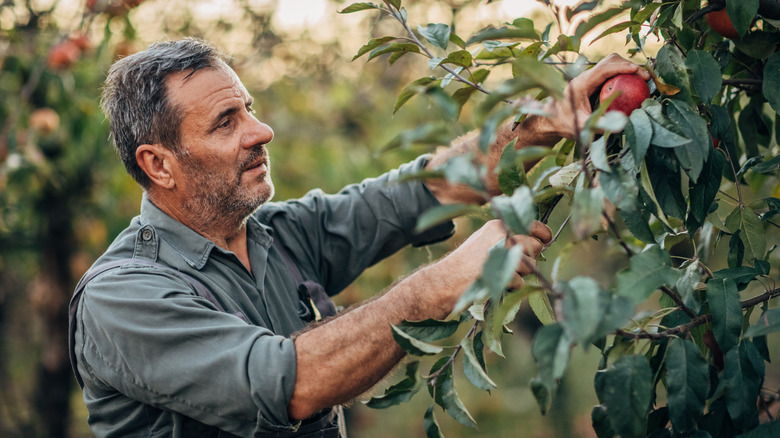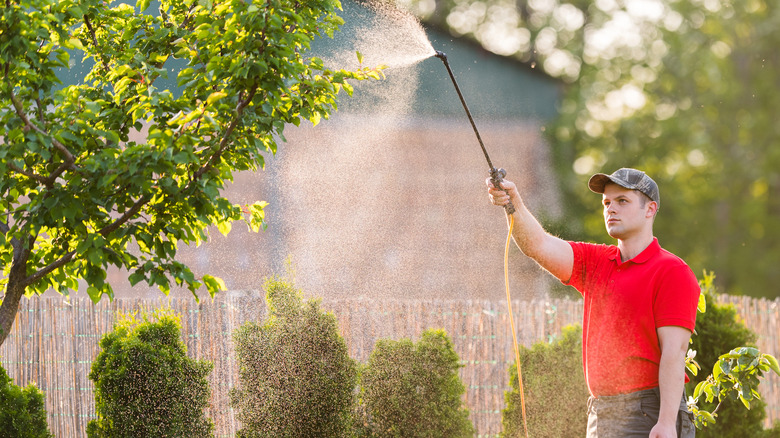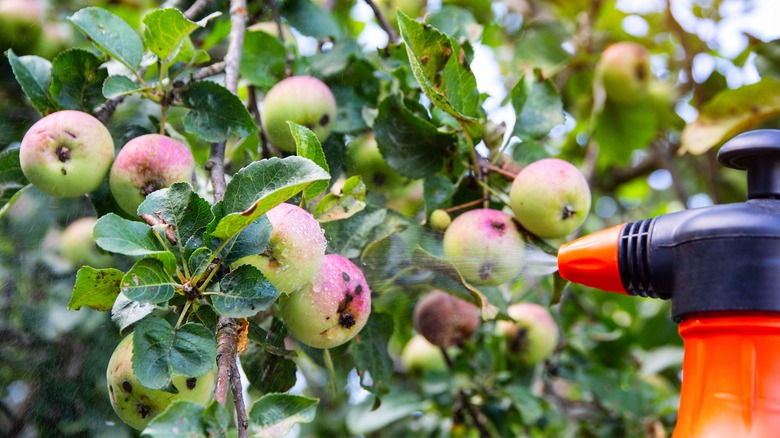Keep Pests And Diseases From Harming Your Fruit Tree With An Easy DIY Solution
If you're the proud parent of fruit trees in your backyard, then you are probably well acquainted with the growing pains of the many pests and diseases that often flourish in their company. Pests like aphids, caterpillars, and fruit flies are happy to infest fruit trees, wreaking havoc on leaves, flowers, and fruits. Moreover, diseases like powdery mildew, apple scab, or bacterial canker can infect your tree, weakening its immune system and ultimately causing stunted growth, defoliation, or fruit rot. Any of these issues can be tough to tackle and will unfortunately impact the yield and quality of your fruit come harvest time. While it may be tempting to call up an exterminator or a specialist to tend to your arbor issues, there's a great DIY solution you should try first. Pick up a bottle of neem oil at your local nursery and watch how your pest and disease problems drift away.
Neem oil is an excellent, natural solution to use in your garden for managing pests and diseases that frequent fruit trees. It's derived from the neem tree and contains compounds that help to disrupt the life cycle of pests by interfering with their feeding, reproduction, and growth. Therefore it's a great pesticide but also repellent as the potent smell can repel some insects, too. Additionally, neem oil is renowned for its antifungal properties, making it a great solution for powdery mildew, leaf spot, or blight. It's a great alternative to try before investing in harmful synthetic pesticides or calling an expensive exterminator.
When and how to use neem oil
Neem oil can be a great DIY solution as an alternative to pesticides or a professional tree service for maintaining fruit trees. Garden Design recommends using neem oil on fruit trees in the winter or dormant seasons. This application will help to kill any insect eggs that may be using the tree as shelter during the colder months. Later, you can continue to use neem oil throughout the growing season as a repellent or to control any infestations that may arise. It's best to apply neem oil just before your fruit trees blossom and after the petals drop to protect the flowers and avoid harming pollinators. Once the petals fall, you can resume applications every two weeks or as needed.
There are two different ways you can apply neem oil to your fruit trees. The first is as a foliar spray. Using a spray bottle, cover the leaves and branches of the trees. Be sure to dilute the solution first if your product calls for it, though some can be sprayed directly from the bottle. Alternatively, you can use neem oil as a soil drench. To do so, mix a tablespoon of neem oil with a teaspoon of dish soap until combined. Then dump them into a gallon of warm water and use the solution to drench the soil around your fruit trees. The roots will absorb the neem oil, protecting the plant from the inside out as a natural bug repellent.
Cautions for this method
Though neem oil is generally considered safe and environmentally friendly, there are some precautions to keep in mind when using it to prevent pests or diseases from affecting your fruit trees. Before applying neem oil to any of your plants, it's important to read the product label for the proper dilution instructions. At high concentrations, neem oil can harm beneficial pollinators, like honey bees, or damage the foliage or blossoms on your tree. While some products arrive in spray bottles pre-diluted, some require you to manually dilute them to be effective. Once you apply it correctly, wait to see how your tree responds before a second application. If you notice any adverse effects, do not repeat use. Assess the damage to determine how to proceed and contact a local nursery for tips on how to help your tree recover.
As each neem oil product is manufactured differently, some may contain additives that can increase the phytotoxicity of your fruit trees, meaning that in the right heat or sunlight, the presence of neem oil on plant tissues can cause serious damage to leaves, blossoms, or branches. For this reason, it's important to apply neem oil in the early morning or late afternoon and not on days that have a high-temperature forecast. Applying neem oil when the sun is less intense will help to protect your fruit trees from damage, ensuring you have greater protection from the oil and less impact on your harvest.


